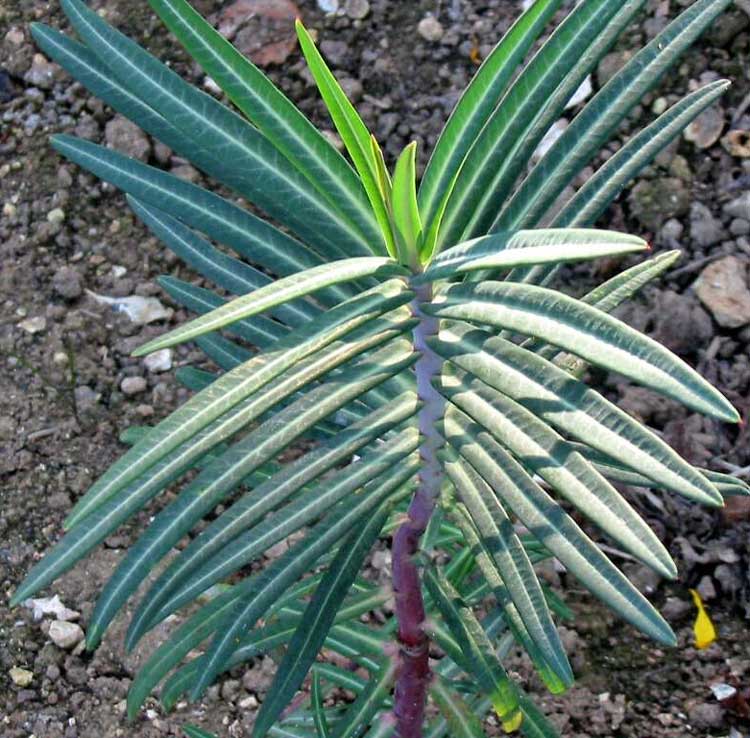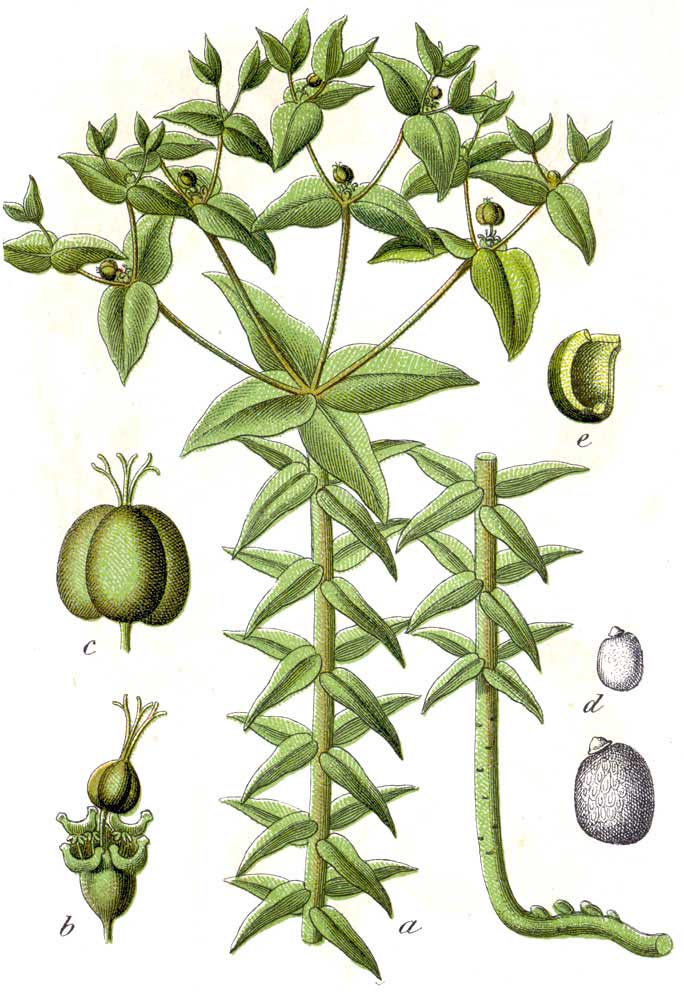
Euphorbia lathyris (*)
Classification System: APG IV
Superregnum: Eukaryota
Regnum: Plantae
Cladus: Angiosperms
Cladus: Eudicots
Cladus: Core eudicots
Cladus: Rosids
Cladus: Eurosids I
Ordo: Malpighiales
Familia: Euphorbiaceae
Subfamilia: Euphorbioideae
Tribus: Euphorbieae
Subtribus: Euphorbiinae
Genus: Euphorbia
Subgenus: E. subg. Esula
Sectio: E. sect. Lathyris
Species: Euphorbia lathyris
Name
Euphorbia lathyris L., 1753
Synonyms
Homotypic
Tithymalus lathyris (L.) Hill, Hort. Kew.: 172.3 (1768).
Euphorbia decussata Salisb., Prodr. Stirp. Chap. Allerton: 389 (1796), nom. superfl.
Galarhoeus lathyris (L.) Haw., Syn. Pl. Succ.: 143 (1812).
Galarhoeus decussatus Gray, Nat. Arr. Brit. Pl. 2: 256 (1821 publ. 1822), nom. superfl.
Keraselma lathyris (L.) Raf., Fl. Tellur. 4: 116 (1838).
Epurga lathyris (L.) Fourr., Ann. Soc. Linn. Lyon, n.s., 17: 150 (1869).
Euphorbion lathyrum (L.) St.-Lag., Ann. Soc. Bot. Lyon 7: 126 (1880).
Heterotypic
Tithymalus cataputia Garsault, Fig. Pl. Méd.: 593 (1764), opus utique oppr.
Euphorbia spongiosa Ledeb. ex Schrank, Syll. Pl. Nov. 1: 214 (1824).
Euphorbia lathyris var. minor Hook. & Arn., Bot. Beechey Voy.: 44 (1830).
Homonyms
Euphorbia lathyris Georgi, nom. illeg. = Euphorbia fischeriana Steud.
Distribution
Native distribution areas:
Continental: Asie
Regional: Central Asie
China, Pakistan

Euphorbia lathyris
References: Brummitt, R.K. 2001. TDWG – World Geographical Scheme for Recording Plant Distributions, 2nd Edition
References
Primary references
Linnaeus, C. 1753. Species plantarum, exhibentes plantas rite cognitas, ad genera relatas, cum differentiis specificis, nominibus trivialibus, synonymis selectis, locis natalibus, secundum systema sexuale digestas. Tomus I. Pp. [I–XII], 1–560. Impensis Laurentii Salvii, Holmiae [Stockholm]. BHL Reference page. : 457.
Links
Govaerts, R. et al. 2020. Euphorbia lathyris in World Checklist of Selected Plant Families. The Board of Trustees of the Royal Botanic Gardens, Kew. Published online. Accessed: 2020 Jul 02. Reference page.
International Plant Names Index. 2020. Euphorbia lathyris. Published online. Accessed: Jul 02 2020.
Govaerts, R. et al. 2020. Euphorbia lathyris in Kew Science Plants of the World online. The Board of Trustees of the Royal Botanic Gardens, Kew. Published online. Accessed: 2020 Jul 02. Reference page.
Tropicos.org 2020. Euphorbia lathyris. Missouri Botanical Garden. Published online. Accessed: 02 Jul 2020.
USDA, ARS, Germplasm Resources Information Network. Euphorbia lathyris in the Germplasm Resources Information Network (GRIN), U.S. Department of Agriculture Agricultural Research Service. Accessed: 08-Apr-12.
Vernacular names
čeština: Pryšec skočcový
Deutsch: Kreuzblaettrige Wolfsmilch, Spring-Wolfsmilch, Springwurz
English: Myrtle Spurge, Mole plant, Gopher plant, Mole weed, Wild Caper, Caper Spurge
español: Contrarrayo, Matarratones, Tartago
suomi: Ristityräkki
français: Euphorbe épurge
italiano: Catapuzza
日本語: ホルトソウ
Nederlands: Kruisblad-Wolfsmelk
português: Catapucia-menor, Morganheira
slovenščina: križnolistni mleček
中文: 续随子,千金子
Euphorbia lathyris, the caper spurge or paper spurge, is a species of spurge native to southern Europe (Italy, Greece, Spain, Portugal), northwest Africa, and eastward through southwest Asia to western China.[1][2][3]
Other names occasionally used include gopher spurge, gopher plant or mole plant.[1]
Growth
It is an erect biennial (occasionally annual) plant growing up to 1.5 m tall, with a glaucous blue-green stem. The leaves are arranged in decussate opposite pairs, and are lanceolate, 5–15 cm long and 1-2.5 cm broad, glaucous blue-green with a waxy texture and pale greenish-white midrib and veins. The flowers are green to yellow-green, 4 mm diameter, with no petals. The seeds are green ripening to brown or grey, produced in globular clusters 13–17 mm diameter of three seeds compressed together.[3][4]
Chemical characteristics
All parts of the plant, including the seeds and roots, are poisonous. Handling may cause skin irritation as the plant produces latex. While poisonous to humans and most livestock, goats sometimes eat it and are immune to the toxin. However, the toxin can be passed through the goat's milk.[5]
Habitat
Away from its native range, it is widely naturalised in many regions, where it is often considered an invasive weed.[1][2][4] It grows in partial shade to full sun in USDA zones 5–9.
Uses
It is used in folk medicine as a remedy for cancer, corns, and warts and has purportedly been used by beggars to induce skin boils.[6]
References
"Euphorbia lathyris". Germplasm Resources Information Network (GRIN). Agricultural Research Service (ARS), United States Department of Agriculture (USDA). Retrieved 1 January 2018.
Flora Europaea: Euphorbia lathyris
Blamey, M. & Grey-Wilson, C. (1989). Flora of Britain and Northern Europe. ISBN 0-340-40170-2
Huxley, A, ed. (1992). New RHS Dictionary of Gardening. ISBN 0-333-47494-5
Poisonous Plant Information: Caper Spurge Archived 2006-10-20 at the Wayback Machine
Purdue University: Euphorbia lathyris
Taxon identifiers
Wikidata: Q164223 Wikispecies: Eu
Retrieved from "http://en.wikipedia.org/"
All text is available under the terms of the GNU Free Documentation License

